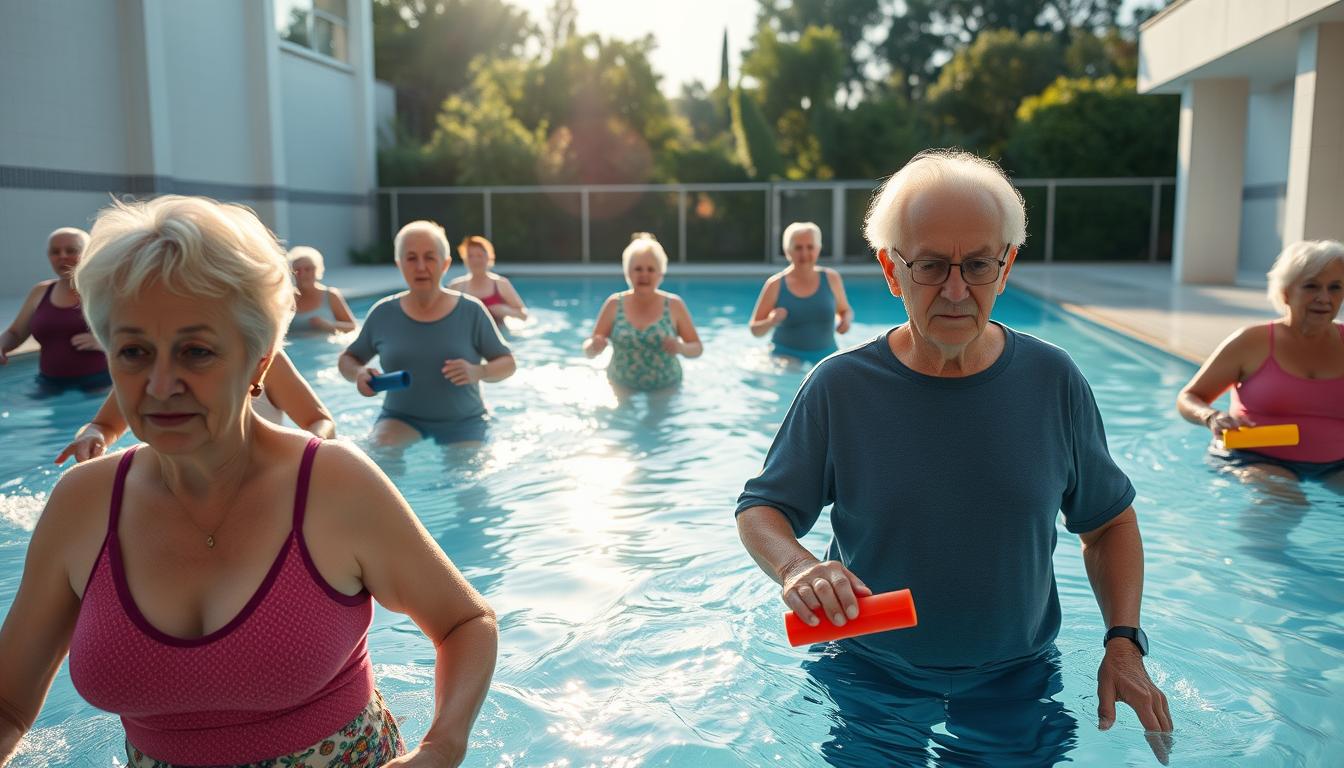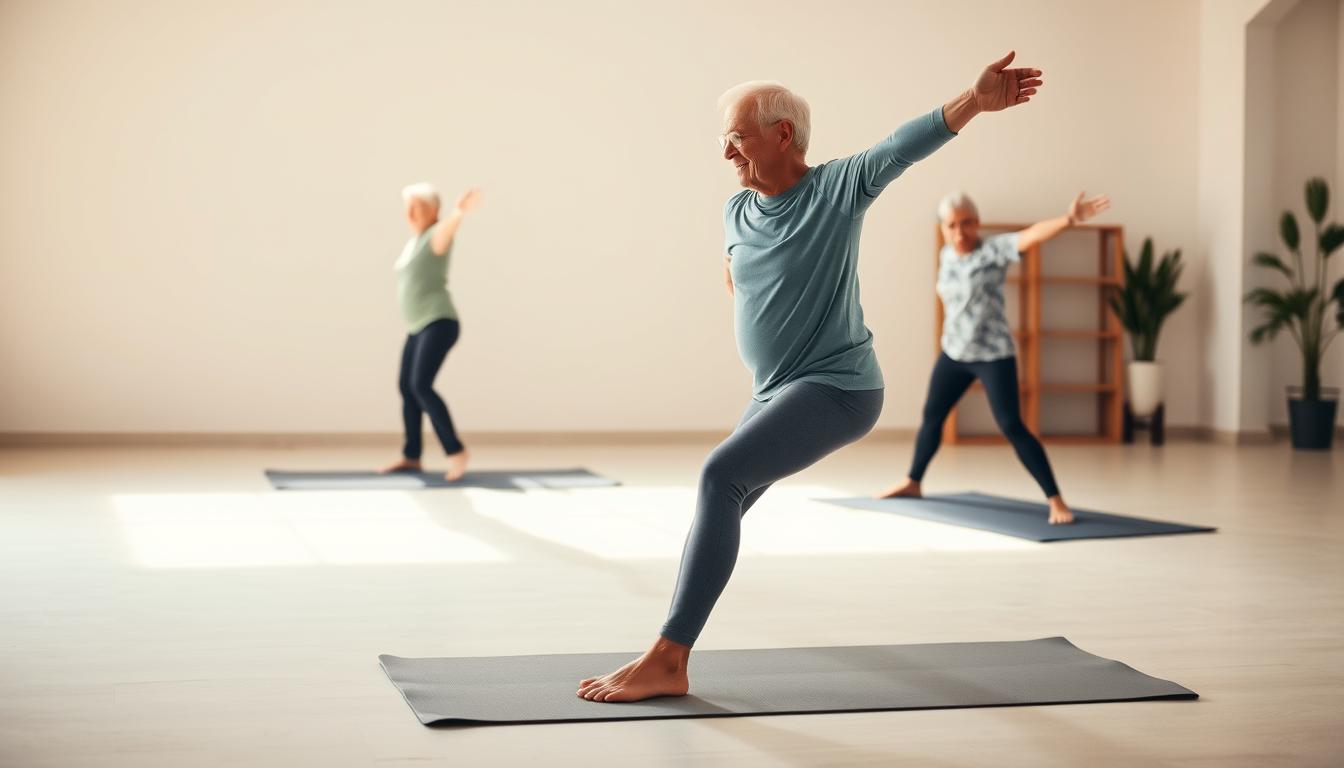Want to ditch joint pain without sacrificing your workout? Try walking in the shallow end of a pool—it’s like giving your knees a vacation while still building strength. I’ve seen clients with arthritis go from “ouch” to “oh, this actually works?” in weeks by embracing this low-impact routine.
Here’s why it clicks: Water’s buoyancy supports 90% of your body weight, so your joints aren’t screaming for mercy. But don’t let the gentle vibe fool you—the resistance turns every step into a mini strength-training session. One Medical recommends starting with 10-minute sessions, but hey, even five minutes counts. Pro tip: If you can walk to the mailbox without wincing, you’re already overqualified for this.
I tell my students to think of it as a lazy river with benefits. Move forward, backward, or sideways—whatever keeps things interesting. One client joked it’s the only workout where you can gossip with friends and improve heart health simultaneously. (She’s not wrong.)
The key? Start slow. Focus on posture: shoulders back, core engaged, no slouching like a bored teenager. If your legs feel like they’re pushing through peanut butter, you’re doing it right. And if you need a break? Just float—nobody’s judging.
Getting Started with Pool Workouts for Joint Relief
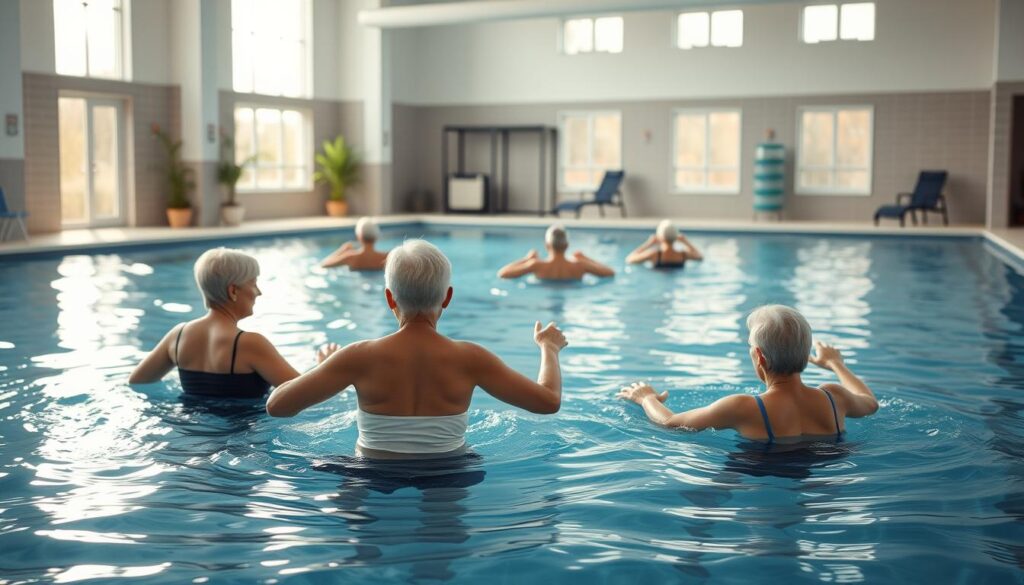
Ever feel like your joints need a vacation from gravity? That’s where shallow-end workouts shine. I’ve watched folks transform stiff, achy mornings into fluid motion by trading pavement for pool tiles—and trust me, you don’t need Olympic-level skills to reap the rewards.
Why Water Feels Like Liquid Gym Equipment
Here’s the magic: Moving through H2O is like pushing against nature’s resistance bands. Every step works your legs and arms 12x harder than air—without the joint punishment. Think of it as strength training for people who hate dumbbells. Pro tip: If you can stir a thick soup, you’ve already mastered the basic motion.
| Activity | Land Impact | Water Impact |
|---|---|---|
| Walking | High (knees/hips) | Low (buoyancy-supported) |
| Arm Circles | Moderate (shoulders) | High (resistance-built) |
| Leg Lifts | Risky (lower back) | Safe (water-supported) |
Shallow-End Smarts: No Lifeguard Required
Stick to waist-depth areas—you know, where you can still wave at grandkids without swallowing pool water. Grip the edge if balance feels shaky at first. And hey, pool noodles aren’t just for kids; they’re cheat codes for staying upright while working your core.
Three non-negotiable rules: 1) Wear grippy sandals near the ladder (slippery tiles wait for no one), 2) Sip water even if you’re surrounded by it, and 3) Stop if something feels “off.” Your body’s smarter than any fitness tracker—listen to it.
Start with 2-3 laps forward, then try moonwalking backward. Sounds silly? That’s the point! Laughter burns calories too, you know what I mean?
Water Walking Exercises for Seniors: Step-by-Step Techniques
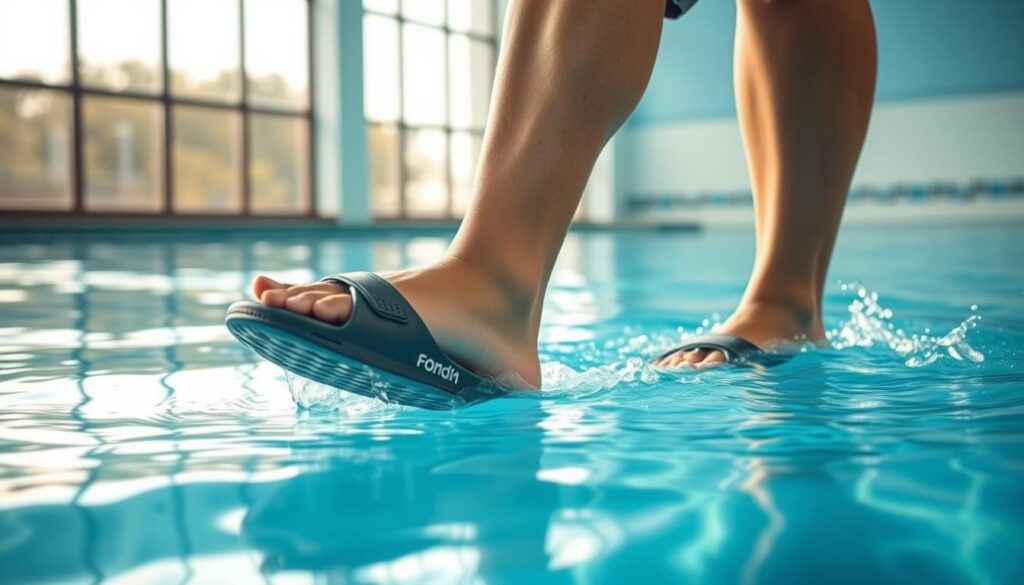
Ever tried standing in a pool and felt like the water’s hugging your joints? That’s your cue to get moving. I’ll show you how to turn that gentle resistance into a full-body tune-up—no floaties required.
Posture First, Splash Second
Stand tall like you’re balancing a book on your head—chin up, shoulders rolled back. Grip the pool edge if needed, but don’t death-grip it. Your core? Engage it like you’re bracing for a dad joke. Now march forward, knees lifting higher than your enthusiasm at a 7am water aerobics class.
Three form checkpoints:
- No leaning forward (you’re not chasing a bus)
- Toes pointed straight, not duck-style
- Arms slicing through water like they’re parting curtains
Level Up: Resistance Without the Struggle
Once basic steps feel easy, crank it up. Try “slow-mo mode”—take 3 seconds per step. Feel that burn? That’s your muscles high-fiving each other. Add arm raises: palms pushing downward as you step, like you’re sealing an imaginary jar with each movement.
| Technique | Beginner | Advanced |
|---|---|---|
| Stride Length | Short steps | Exaggerated lunges |
| Arm Involvement | Gentle pushes | Full overhead reaches |
| Speed | Leisurely pace | Brisk “I’m late for aqua-Zumba” tempo |
Leg lifts? Do them sideways—it’s like giving your hips a new language to speak. One client calls these “underwater jazz hands.” Pro tip: If you start wobbling, pretend you’re in a music video. Confidence is 50% of the workout.
Track progress by how long you can maintain form. Could barely do two minutes? Next week, aim for three. Celebrate when your “ugh, this is work” face becomes a “heck yeah” smirk. That’s your body adapting—one splashy step at a time.
Mixing Up Your Routine with Innovative Variations
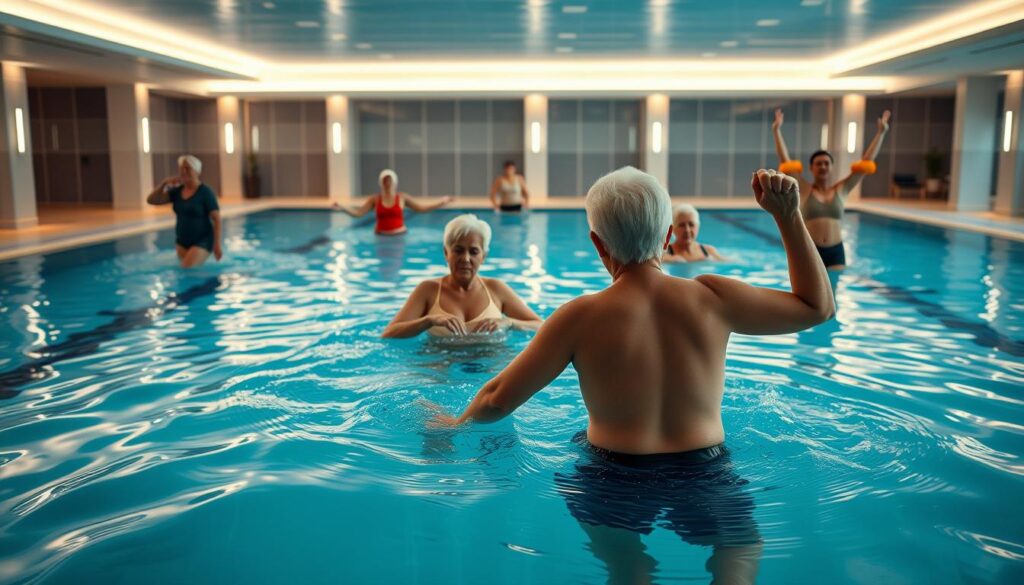
Bored of the same old pool laps? Let’s jazz things up. Your aquatic sessions can feel like a whole new game with a few smart tweaks—think of it as remixing your favorite song but for fitness.
Adding Jogging Intervals and Flutter Kicks
Swap your regular stride for jogging in place—it’s like bouncing on a cloud with resistance. Start with 30-second bursts: pump those arms like you’re chasing the ice cream truck. The water turns each lift into a low-impact power move for your legs and heart.
Next, grip the edge and try flutter kicks. Point your toes, keep legs straight, and kick like you’re drawing circles with your heels. One client said it feels like “being a mermaid with a gym membership.” Pro tip: If your core isn’t whispering sweet burns, kick faster!
| Move | Land Impact | Pool Benefit |
|---|---|---|
| Jogging | Knee stress | Quad sculpting |
| Flutter Kicks | Back strain | Core activation |
Incorporating Side and Forward Lunges
Side lunges turn the pool into a balance studio. Step wide to the right, bend that knee (no collapsing inward!), then push back like you’re dodging a slow-mo tennis ball. Alternate sides—it’s a hoot for your glutes and hips.
Forward lunges? Pretend you’re bowing to royalty, but way cooler. Keep your front knee over the ankle, and rise with control. Feeling fancy? Add arm circles mid-lunge. Suddenly, you’re not just working legs—you’re engaging that upper body too.
Mix these moves for a “choose-your-own-adventure” workout. Did 10 minutes fly by? That’s your cue to level up. Remember: Tiny changes—like speeding up or stretching your stride—can reignite progress faster than a poolside margarita machine.
Enhancing Your Pool Workout with Resistance Tools
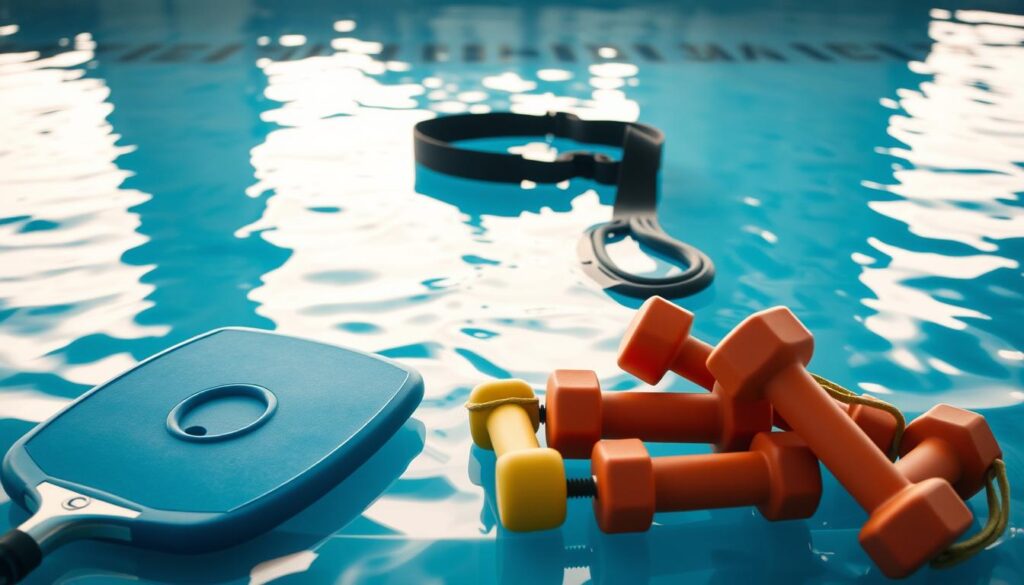
Ready to turn your pool routine into a muscle-toning party? Adding simple gear transforms your aquatic moves from “nice” to “whoa, where’d these arm muscles come from?” I’ve watched clients double their strength gains just by strapping on foam weights—no gym membership required.
Implementing Water Weights and Resistance Gloves Safely
Start with foam dumbbells—they’re like handheld paddles that make every arm lift count. Grip them palms-down, push through the water like you’re smoothing a wrinkled tablecloth. Too easy? Add wrist weights. One client calls them “secret sauce for jiggly triceps.”
Resistance gloves turn your hands into mini propellers. Spread your fingers wide during side steps—it’s like high-fiving the water with every move. Pro tip: Keep elbows slightly bent to protect joints. If your shoulders whisper “nope,” switch to shorter movements.
Three rules for smart resistance:
- Start light—1-2 pound weights are plenty
- Use the pool wall for balance during leg lifts
- Alternate between upper body and lower body moves
See that noodle floating nearby? Thread it under your arms during squats. Suddenly, you’re working your core while giving your legs a resistance boost. One 72-year-old regular does this while singing show tunes—her balance improved faster than her pitch.
Track progress by how long you can maintain good form. Could do 10 bicep curls last week? Aim for 12 today. Remember: Water’s resistance works both ways. Ease up if movements feel jerky—smooth equals strong.
Most importantly? Have fun with it. Try “weighted” jazz hands during side steps or pretend you’re pushing through invisible Jell-O. Laughter + resistance = fitness magic.
Boosting Core Strength and Stability in Water
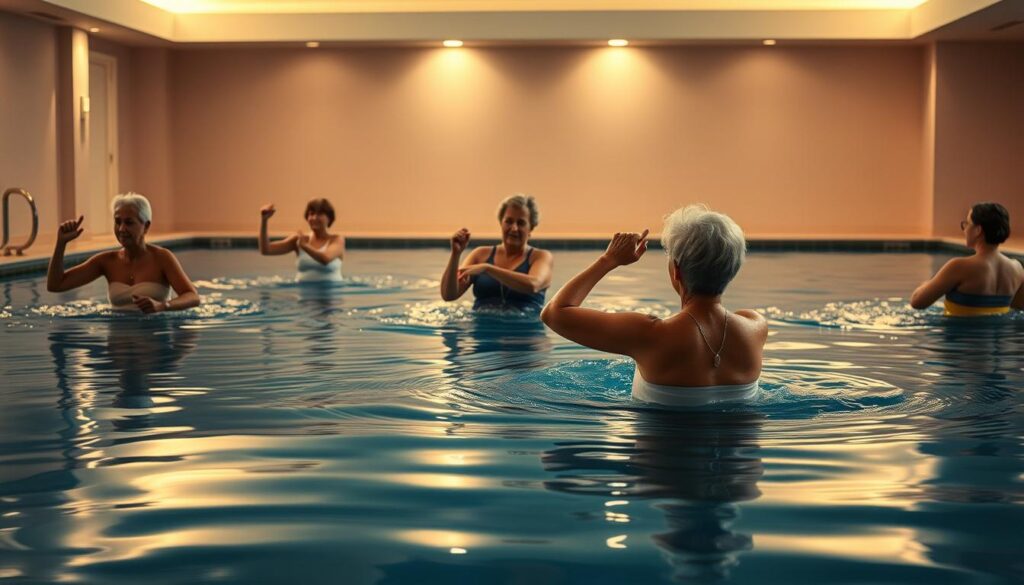
Ever notice how standing in water makes you feel steadier? That’s your core secretly working overtime. I’ve seen clients transform wobbly knees into rock-solid stability by treating the pool like a liquid balance board—no fancy gear required.
Here’s the secret sauce: Water’s gentle push-pull forces your muscles to constantly adjust. Start by pretending you’re wearing an invisible corset—gently tighten your midsection like you’re zipping up snug jeans. Hold that while walking sideways. Feels like a workout? Good. That’s your core high-fiving your balance.
Simple Techniques for Maintaining Balance
Try the “tree pose” of pool workouts: Lift one knee, hold for 5 seconds, and switch. Can’t last that long? No sweat—even 2 seconds counts. Use the pool wall as a safety net until confidence kicks in. One regular calls this her “flamingo drill” (complete with terrible bird impressions).
Three no-fail moves I swear by:
- Heel-toe walks: Place one foot directly in front of the other like a tightrope pro
- Slow-mo leg swings: Kick forward like you’re nudging a beach ball
- Arm sweeps: Push water sideways while marching—it’s like conducting an orchestra
Mix these into your routine 2-3 times weekly. Track progress by how long you can stand on one leg while brushing your teeth at home. Improved? Thank your newfound aquatic stability.
Pro tip: Laugh when you wobble. It burns calories and keeps things light. Remember—every splashy misstep is your body learning. Before long, you’ll move through water like it’s your personal stability zone.
Wrapping Up Your Pool Routine with Practical Next Steps
Ready to make waves? Your pool routine becomes powerful when you treat it like a favorite weekly ritual—not a chore. I’ve watched clients transform “maybe tomorrow” energy into unstoppable momentum by following three rules: consistency beats intensity, listen to your body, and keep it fun.
Block time slots for water exercises like you would doctor’s appointments. Three 20-minute sessions weekly? Better than one marathon splash-fest. Pair up with a friend who shares your fitness goals—nothing bonds people faster than synchronized leg kicks and terrible poolside jokes.
Track progress in small wins. Couldn’t balance on one leg last month? Now you’re doing 10-second holds while humming show tunes? That’s health magic happening. Swap basic moves for water weights once movements feel too easy—your arms will thank you later.
Finally: Chat with your doc before diving into new challenges. Your body’s whispers (“twinge here,” “tightness there”) matter more than any workout plan. Remember—the best pool exercises are the ones you’ll actually keep doing. Now grab that towel and go make a splash—your joints are waiting.
